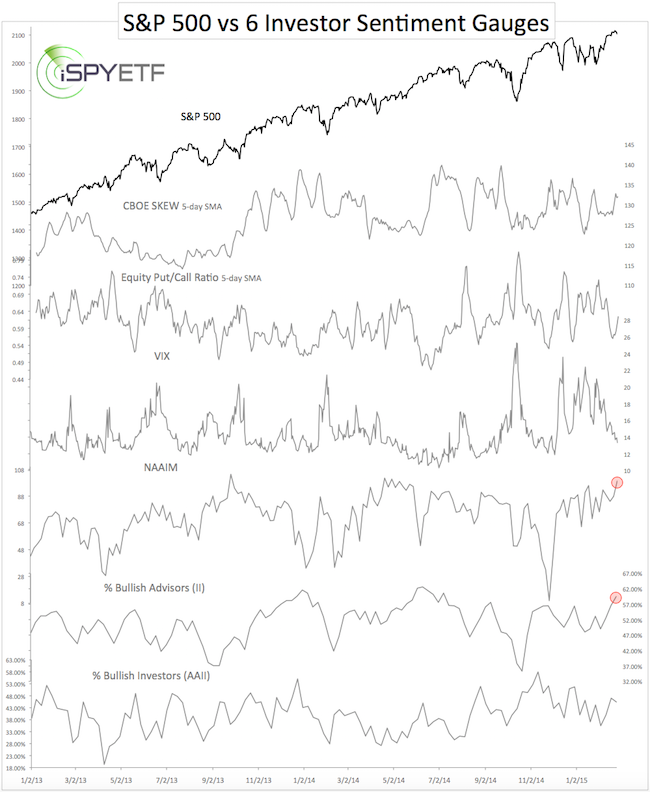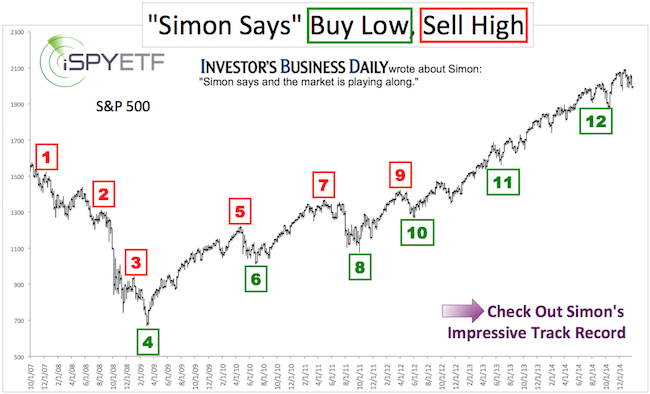“It was the best of times, it was the worst of times, it was the age of wisdom, it was the age of foolishness.”
Charles Dickens classic novel “A Tale of Two Cities” describes London and Paris during the French Revolution, but it could also be applied to Wall Street post 2009.
It is the ‘best of times’ as the S&P 500 (NYSEArca: SPY), Dow Jones (NYSEArca: DIA) and Russell 2000 (NYSEArca: IWM) move from one all-time high to the next. Even the Nasdaaq (Nasdaq: QQQ) is within striking distance of its all-time high.
It is also the ‘worst of times’ for many permabears, who continue to trash talk every rally … and get crushed.
Some of you may remember my inflammatory message for stock market bears published in the July 13, 2014 Profit Radar Report:
“Here’s a message for everyone vying to be the next Roubini: A watched pot doesn’t boil and a watched bubble doesn’t burst. The stock market is not yet displaying the classic warning signs of a major top. There will be a correction, but the bull market won’t be over until most bears turn into bulls or the media stops listening to crash prophets.”
Looking for more stock market analysis? >> Sign up for the FREE iSPYETF e-Newsletter
My bullish conviction was rooted primarily in extreme investor pessimism (reflected by the following July 2013 headlines) and the absence of the one ingredient that foreshadowed the 1987, 2000 and 2007 crashes (more details here).
-
MarketWatch: “If ever there were a time for a stock sell signal, it’s now”
-
CNBC: “Market will crash, just don’t know catalyst: Faber”
-
Reuters: “Billionaire activist Carl Icahn says ‘time to be cautious’ on U.S. stocks?”
-
CNBC: “I’m selling 6 times more than buying: Wilbur Ross”
Today, we are back at (or near) all-time highs and read headlines such as: “Why the smart money is bailing out of the bull market.”
Indeed, the ‘smart money’ is selling stocks as the ‘dumb money’ is rushing in.
Is this bearish? If so, how bearish is it?
Here is a look at six different sentiment gauges consistently tracked by the Profit Radar Report.

Of the six Profit Radar Report staples, only four show extreme optimism:
Newsletter writers polled by Investors Intelligence (II) are the most bullish since June 2014 and active investment managers (polled by NAAIM) haven’t been as bullish since November 2013.
The VIX is low, but needs to shed another 20% before reaching last year’s extreme.
The CBOE equity put/call ratio and CBOE SKEW are only in midly bearish territory.
The media seems somewhat suspicious of new highs, but not nearly as bearish as in June/July 2014.
To be fair, a number of ancillary sentiment gauges match the kind of sentiment extremes seen in December 2010 and 2013.
Looking for more stock market analysis? >> Sign up for the FREE iSPYETF e-Newsletter
My interpretation is that current gains will soon be given back, but any correction now or in the near future is likely to be followed by new recovery highs later on.
What’s the benefit of following the above six sentiment gauges?
Here is a more detailed track record published in the the December 2014 Sentiment Picture (the biggest reason to worry about stocks right now is listed at the bottom of this article):
“Throughout 2014 many analysts, market timers, the media and ‘experts’ opined that the bull market is on borrowed time, largely because investor sentiment has been extremely bullish. Here are two examples:
-
Title: The boys who cried wolf: Crash prophets on the rise - Yahoo on May 2:
Article excerpt: “The Dow Jones closed at an all-time high, which doesn’t change the views of the collection of Cassandras calling for a stock market crash. This group, including esteemed figures like Jeremy Grantham and Marc Faber have been emerging from their bomb shelters with relative frequency over the last month to reiterate their bearish views and insist they weren’t wrong with earlier calls, just early.”
-
Title: If ever the stock market flashed a ‘sell’ signal, it’s now – MarketWatch on July 9
Article excerpt: “Sentiment indicators such as Investors Intelligence are at historic highs (that is bearish), and the RSI Wilder indicator is telling us the market is seriously overbought. Yes, the market can still go higher, but it’s on borrowed time. Don’t believe me? When you are standing 17,000 points in the air at the top of Dow Mountain, and the market is priced for perfection, there is nowhere to go but down.”
This widespread display of pessimism has been baffling and unfounded based on our set of sentiment gauges. At no point in 2014 did optimism reach levels suggestive of a major top. As the small selection of recent Sentiment Picture observations shows, an objective and in depth analysis of investor sentiment has persistently pointed to higher prices.
November 30 Sentiment Picture: “Investor sentiment is not at the kind of extremes usually associated with major market tops. Seasonality may draw prices lower temporarily, but the majority of sentiment gauges point towards higher prices later this year and/or early next year.”
October 31 Sentiment Picture: “In short, investor sentiment allows for further up side.”
September 25 Sentiment Picture: “Few sentiment gauges were at extremes on September 19, when the Dow Jones, S&P 500 and Nasdaq reached their new highs. If this selloff is commensurate to the lack of sentiment extremes at the actual high, it should be on the shallow side.”
August 29 Sentiment Picture: “The overall sentiment picture is fractured, and void of the ‘all in’ mentality seen near major market tops. Isolated extremes cause only small pullbacks here or there.”
The December Sentiment Picture shows a small up tick in ‘dumb money confidence’ (AAII, NAAIM) and complacency by option traders (CBOE Equity Put/Call Ratio). The CBOE SKEW is elevated.
Those readings could contribute to a pullback, but optimism is not pronounced enough to be indicative of a major top.”
The Biggest Reason to Worry about Stocks Right Now
Simon Maierhofer is the publisher of the Profit Radar Report. The Profit Radar Report presents complex market analysis (S&P 500, Dow Jones, gold, silver, euro and bonds) in an easy format. Technical analysis, sentiment indicators, seasonal patterns and common sense are all wrapped up into two or more easy-to-read weekly updates. All Profit Radar Report recommendations resulted in a 59.51% net gain in 2013 and 17.59% in 2014.
Follow Simon on Twitter @ iSPYETF or sign up for the FREE iSPYETF Newsletter to get actionable ETF trade ideas delivered for free.

|